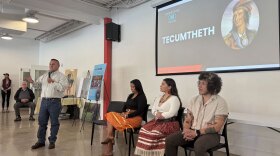-
In 1843, the Wyandot tribe was forced to leave Ohio. They had to walk 150 miles from Upper Sandusky to Cincinnati, leaving behind all they built in the Sandusky River Valley.
-
Members of the Wyandot Nation were the last Indigenous tribe to be removed from Ohio. Students from the University of Cincinnati worked with the tribe to help tell their story through a series of historical markers to be installed across the state.
-
Tecumseh is a renowned Shawnee leader known for his resistance to American colonialism. The Sunday event in Springfield gave his descendants a chance to visit their Ohio homelands and share their lives with Ohioans.
-
Ohio State University is currently the only school in the state that prohibits most land acknowledgments, citing Senate Bill 1. Miami University in Oxford doesn’t see the law the same way.
-
A land acknowledgement is a verbal or written statement that recognizes that land was taken from Indigenous people. Ohio State's policy says they are considered statements "on behalf of an issue or cause" and they cannot be given by a university department or at university-sponsored events.
-
"St. Clair’s Defeat Revisited: A New View of the Conflict" aims to share Ohio Indigenous history. It's among hundreds of National Endowment for the Humanities grant recipients to lose funds under the Trump administration.
-
Health, Science & EnvironmentIndigenous communities across the world founded the practice of prescribed fires in their respective homelands. And in the Dayton region, the Myaamia tribe was one of those groups.
-
The podcast explores hundreds of years of history of the Shawnee tribes of Ohio and how they're reconnecting to the land today.
-
Health, Science & EnvironmentGreat Council State Park opened this month – the first and only to feature a center honoring Ohio’s Native peoples.
-
WYSO got a sneak peek into some features of the Great Council State Park, set to open later this week.
© 2025 �ǿ�����ý
Play Live Radio
Next Up:
0:00
0:00
Available On Air Stations








